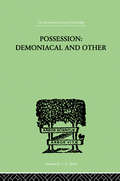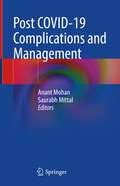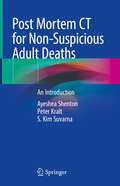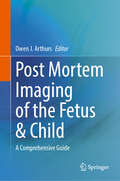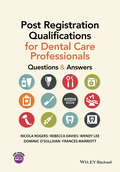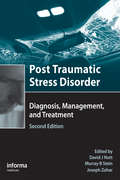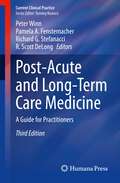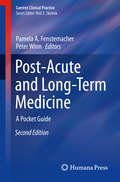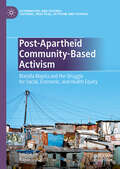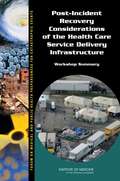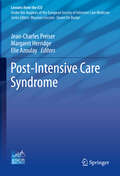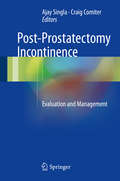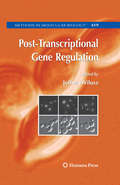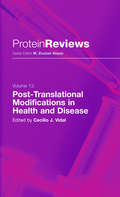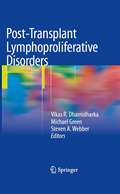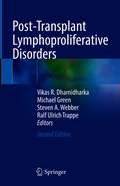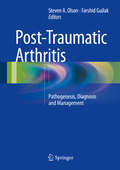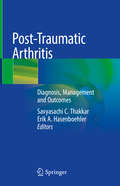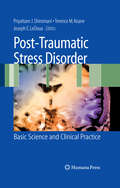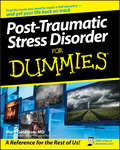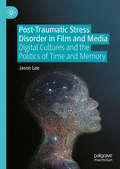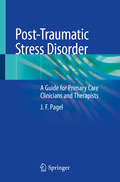- Table View
- List View
Possession, Demoniacal And Other: Among Primitive Races, in Antiquity, the Middle Ages and Modern
by Oesterreich, T KThis is Volume III of six in a series on Anthropology and Psychology. Originally published in 1930, this collection of papers looks at possession, demonical and other, among primitive races, in antiquity, the Middle Ages and modern times.
Post COVID-19 Complications and Management
by Saurabh Mittal Anant MohanThe book covers all aspects of clinical manifestations and management of various complications following acute coronavirus disease 2019 (COVID-19). COVID-19 is considered a multisystem disease and may lead to long-term complications and sequelae in various organ systems, some of whom may severely impair quality of life and may cause higher mortality. The current understanding of these complications is still incomplete and unclear, consequently the management strategies are not well elucidated. This book provides an extensive review of the current understanding of post COVID-19 complications and a simple, yet rational approach to their management.The chapters include complications related to multiple organ systems of the body including the respiratory system, nervous system, cardiovascular system, psychiatric issues, endocrine abnormalities, and others. Every chapter provides a detailed description of a practical approach to chronic sequelae along with important summary points for quick reference. Each chapter provides easy-to-follow algorithms and key points. This book will assist medical practitioners in understanding various aspects of post COVID-19 complications and will be helpful for general practitioners, internists, pulmonologists and other healthcare workers dealing with patients with COVID-19. It will also be useful to undergraduates and postgraduates since COVID-19 has been included in medicine curriculum.
Post Mortem CT for Non-Suspicious Adult Deaths: An Introduction
by S. Kim Suvarna Ayeshea Shenton Peter KraltThis book is an ideal introduction to the specialty of post mortem computed tomography (PMCT). It will serve as a comprehensive yet accessible guide to the understanding and interpretation of whole-body studies for both hospital and community settings. Both normal post mortem appearances and findings associated with a wide range of diagnoses encountered in real cases from the coronial service are presented with the aid of numerous images. The coverage encompasses not only findings in all anatomic regions but also the imaging appearances in cases following targeted coronary angiography, attempted cardiopulmonary resuscitation and various special circumstances such as suicide. The inclusion of many practical tips and possible pitfalls will support the radiologist to become more confident when reporting PMCT, while for the more experienced practitioner the wealth of examples will serve as a useful resource. In addition to radiologists, the book will be of value for pathologists at all levels of experience and anyone needing to understand the role and limitations of PMCT.
Post Mortem Imaging of the Fetus & Child: A Comprehensive Guide
by Owen J. ArthursThis book provides state of the art imaging and serves as a reference standard for anyone wanting to begin or improve their post mortem imaging in children. Divided into three parts, the book covers imaging principles and techniques, interpretation of post mortem imaging, and guidance on which imaging technique to use for which clinical scenarios. This is an ideal book for researchers and clinical hospital staff using post mortem imaging for children, including pathologists, radiologists, radiographers, technicians, mortuary staff, fetal medicine & obstetricians, ITU staff, forensic imaging staff and pathologists.
Post Registration Qualifications for Dental Care Professionals
by Nicola Rogers Wendy Lee Dominic O'Sullivan Frances Marriott Rebecca DaviesThis must-have revision aid is aimed at post-certification dental nurses studying for one or more of the post-registration certificates, or more generally, looking to undertake non-verifiable CPD or further their knowledge and skills in advanced topics. Chapters span the following post-certification qualifications: dental sedation nursing, dental radiography, orthodontic nursing, oral health education, special care dentistry and implant dental nursing. In each case questions are written in a multiple choice format and cover the breadth and depth of each topic as necessary for each qualification. This book is intended as a revision aid and therefore questions are designed to fully test the reader's understanding of the subject. Detailed and explanatory answers to all the questions are provided at the end of each chapter. A companion website provides students with a selection of mock questions, mirroring the format of each exam. Formats might include MCQs as well as extended matching questions (EMQs) and short answer questions (SAQs). The book would also be a useful advanced self-assessment guide for trainee dental nurses following the Foundation Degree, National Examination or NVQ pre-registration courses. Features Covers each of the post-certification courses Companion website with mock exam questions
Post Traumatic Stress Disorder: Diagnosis, Management and Treatment
by Graeme TurnerPost Traumatic Stress Disorder can be one of the most disabling of all the anxiety disorders and is frequently misdiagnosed and ineffectively treated It is also an area in which there have been recent major advances This book sets out to solve this problem, presenting doctors with practical guidance and at the same time a state-of-the-art summary o
Post-AIDS Discourse in Health Communication: Sociocultural Interpretations (Routledge Research in Health Communication)
by Ambar BasuThis book examines the discourse of a "post-AIDS" culture, and the medical-discursive shift from crisis and death to survival and living. Contributions from a diverse group of international scholars interrogate and engage with the cultural, social, political, scientific, historical, global, and local consumptions of the term "post-AIDS" from the perspective of meaning-making on health, illness, and well-being. The chapters critique and connect meanings of "post-AIDS" to topics such as neoliberalism; race, gender, and advocacy; disclosure; relationships and intimacy; stigma and structural violence; family and community; migration; work; survival; normativity; NGOs, transnational organizations; aging and end-of-life care; the politics of ART and PrEP; mental illness; campaigns; social media; and religion. Using a range of methodological tools, the scholarship herein asks how "post-AIDS" or the "End of the Epidemic" is communicated and made sense of in everyday discourse, what current meanings are circulated and consumed on and around HIV and AIDS, and provides thorough commentary and critique of a "post-AIDS" time. This book will be an essential read for scholars and students of health communication, sociology of health and illness, medical humanities, political science, and medical anthropology, as well as for policy makers and activists.
Post-Acute and Long-Term Care Medicine: A Guide for Practitioners (Current Clinical Practice)
by Peter Winn Pamela A. Fenstemacher Richard G. Stefanacci R. Scott DeLongThis book addresses current issues surrounding hospital admissions and readmissions and the practice of post-acute and long-term care (LTC). Now in its fully revised and expanded third edition, it contains the most up-to-date knowledge and regulations pertinent to practice in Post-Acute and Long-Term Care Medicine. Post-Acute and Long-Term Medicine is divided into four main sections. The first section is an introduction to long-term care. It includes chapters on home health care, assisted living and residential care, department of veteran affairs and nursing facilities, among others. The second section focuses on clinical medicine in post-acute and long-term care and contains chapters on common clinical conditions, preventing hospital admissions and readmissions, palliative care, weight and nutrition and wound care. The third section details psychosocial aspects of post-acute and long-term care. Chapters in this section describe dementia, delirium, depression, ethical and legal issues and caring for families. The fourth and final section centers on special issues in post-acute and long-term care. This section focuses on documentation and coding, medication management and rehabilitation and maximizing function. The outbreak of COVID-19 has led to two very important new chapters in this section. One chapter discusses challenges and opportunities in post-acute long-term care that have arisen during the pandemic. Another new chapter talks about the importance of virtual care and telemedicine in post-acute and long-term care amidst the COVID-19 outbreak. Written by experts in the field, many of whom have worked within AMDA – The Society for Post-acute and Long-term Care Medicine - to create and disseminate a knowledge base for post-acute and LTC, this is a valuable resource for clinicians and educators seeking to maximize the care and living experience of residents in post-acute and long-term care settings.
Post-Acute and Long-Term Medicine
by Peter Winn Pamela A. FenstemacherThis book addresses current issues surrounding hospital readmissions and the practice of post-acute and long-term care (LTC). Thoroughly updated, the Second Edition of this practical pocket guide presents new regulations governing these services and lessens the uncertainty involved in caring for patients in a long-term care facility. The book is divided into four sections that cover: types of care, which include community care, nursing facility care, and teamwork; clinical medicine, with suggested approaches to common conditions and wound care; psychosocial aspects of care, which include ethical and legal issues and caring for families; and special issues, with chapters on documentation, coding, and medication management. As community-based care is an area of rapid growth where the elderly are increasingly seeking their medical care, new chapters have also been added that describe these programs. Written by expert contributors, many of whom have worked within the American Medical Directors Association to create and disseminate a knowledge base for post-acute and LTC, this is a valuable resource for clinicians and educators seeking to maximize the care and living experience of residents in post-acute and long-term care settings.
Post-Anesthesia Care
by Heitz James W.The initial hours after surgery are a critical time in the care of the surgical patient. Familiarity with the clinical presentation of perioperative complications is important to achieving optimal outcomes. By taking an approach to complications based upon signs and symptoms seen in the early post-operative period among adult patients undergoing non-cardiac surgery, this book aids the practitioner in the clinical management of surgical patients during the often turbulent hours after surgery. After a brief introduction to PACU organization, this manual discusses the common and most serious symptoms encountered in the post-operative patient, giving guidance on diagnosis of the underlying disorder and the treatment options available. The book also includes chapters dedicated to subspecialty patients, including patients requiring post-operative mechanical ventilation, pediatric patients, patients with implantable cardiac devices, morbidly obese patients and the complex pain patient. This practical manual is essential reading for all practitioners working in the PACU environment.
Post-Apartheid Community-Based Activism: Mandla Majola and the Struggle for Social, Economic, and Health Equity (Alternatives and Futures: Cultures, Practices, Activism and Utopias)
by Rajini Srikanth Louise PennerThis book provides a timely study of community-based activism in contemporary South Africa. Grounded in oral history, the book examines the acquired expertise and life experiences of an impactful South African activist, Mandla Majola, within the context of the people, circumstances, and affiliations that have shaped his strategic thinking and practice. The authors situate Mandla Majola’s activist and everyday experiences within histories of the complex connections between post-apartheid political and social movements and human rights discourse as they emerged after 1994. The book illuminates the relationship of state power to public health activism for HIV, tuberculosis and COVID-19 and for a life of basic human dignity, including access to sanitation and housing. Mandla Majola’s life spotlights the inspiring, sometimes grueling, and tireless quotidian work of thousands of “invisible” community-based activists whose collective actions have impacted the entire spectrum of social and economic rights of untold numbers of people in South Africa and beyond.
Post-Incident Recovery Considerations of the Health Care Service Delivery Infrastructure
by Institute of Medicine Bruce M. Altevogt Board on Health Sciences Policy Forum on Medical and Public Health Preparedness for Catastrophic Events Theresa WizemannHealth systems and assets are a large part of the critical infrastructure of any community and are vital not only for the safety and well-being of its citizens, but also for the economic vitality, quality of life, and livelihood of the entire community. As part of its ongoing mission to foster dialogue among stakeholders and to confront the challenges inherent in ensuring the nation's health security, the Institute of Medicine (IOM) Forum on Medical and Public Health Preparedness for Catastrophic Events sponsored a town hall session at the 2012 Public Health Preparedness Summit. This event took place February 21-24 in Anaheim, California. In this session sponsored by the IOM, the focus of discussion was sustaining health care delivery beyond the initial response to a disaster and facilitating the full long-term recovery of the local health care delivery systems. Many elements required for recovery are also fundamental to the day-to-day operations of these systems. Investing in improved health care delivery systems, both financially and through collaborative capacity building, can enhance economic development and growth before a disaster, and also prove instrumental in sustaining services and recovering after a disaster. Post-Incident Recovery Considerations of the Health Care Service Delivery Infrastructure serves as a summary of the session and explains the value of regional capacity building; the importance of interagency, intergovernmental, and public-private collaboration; and the significant role that health care coalitions can play in ensuring resilient communities and national health security.
Post-Intensive Care Syndrome (Lessons from the ICU)
by Jean-Charles Preiser Elie Azoulay Margaret HerridgeThis book, part of the European Society of Intensive Care Medicine textbook series, provides detailed up-to-date information on the physical, cognitive, and psychological impairments that are frequently present following a stay in an intensive care unit and examines in depth the available preventive and therapeutic strategies, including adapted rehabilitation programs. Beyond acquainting readers with the multiple facets of post-intensive care syndrome (PICS), the book aims to promote the effective follow-up of patients, thereby enhancing their ability to work and their functional autonomy, and to identify risk factors for the development of PICS as a stimulus to beneficial organizational changes in intensive care departments.The background to the book is the realization by healthcare providers that the quality of life of patients who have required a stay in an intensive care unit can be severely impaired or even become unacceptable. All too often, the diverse sequelae are overlooked by specialists of other disciplines. Moreover, families and caregivers are also at high risk of post-traumatic stress disorder and depression. The European Society of Intensive Care Medicine has developed the Lessons from the ICU series with the vision of providing focused and state-of-the-art overviews of central topics in Intensive Care and optimal resources for clinicians working in Intensive Care. This book, written by renowned experts in the field, will facilitate the transmission of key knowledge with significant clinical and financial benefits.
Post-Prostatectomy Incontinence
by Ajay Singla Craig ComiterThis text provides a comprehensive, state - of - the art review of this new and emerging field, as the number of men who suffer from post-prostatectomy incontinence increases by greater than 10,000 per year. How to evaluate and manage this devastating disorder has become a necessary part of nearly every urologic practice. This book serves a valuable resource for physicians with an interest in managing patients with post-prostatectomy incontinence. In addition, treatment includes algorithms and suggested office evaluation that will help guide conservative management that is appropriate for most patients. The text provides insight into the history of male incontinence surgery, as well as the current surgical techniques for the operative management of post-prostatectomy incontinence in those who fail conservative management. This text reviews current data regarding surgical outcomes for the most common and newly developed incontinence procedures, as well as step-by-step descriptions of the key surgical steps necessary for success. All chapters are written by world renowned experts in this field and include the most up to date clinical information.
Post-Transcriptional Gene Regulation
by Jeffrey WiluszThis volume strives to present current technical approaches to most aspects of post-transcriptional control and provide the reader with a useful and versatile laboratory bench resource. With chapters split into sections covering bioinformatics, fundamental aspects of the study of RNA biology, and techniques for specific aspects of RNA biology, the expert authors have filled the book with invaluable tricks of the trade, perfected in their laboratories.
Post-Translational Modifications in Health and Disease
by Cecilio J. VidalPost-translational modifications serve many different purposes in several cellular processes such as gene expression, protein folding and transport to appropriate cell compartment, protein-lipid and protein-protein interactions, enzyme regulation, signal transduction, cell proliferation and differentiation, protein stability, recycling and degradation. Although several-hundred different modifications are known, the significance of many of them remains unknown. The enormous versatility of the modifications which frequently alter the physico-chemical properties of the respective proteins represents an extraordinary challenge in understanding their physiological role. Since essential cellular functions are regulated by protein modifications, an improvement of current understanding of their meaning might allow new avenues to prevent and/or alleviate human and animal diseases.
Post-Transplant Lymphoproliferative Disorders
by Michael Green Vikas R. Dharnidharka Steven A. WebberPost-transplant lymphoproliferative disorders are a group of conditions that straddle the borders between infection and malignancy. They were very rare prior to the mid-1980s but now can be expected to develop in 1-10% of transplant recipients. While some cases are reversible with reduction in immunosuppression, more severe forms are indistinguishable from frank lymphomas. This book sets out to cover in depth every aspect of these disorders, including both basic science and clinical topics. The epidemiology is reviewed, and careful attention is paid to the role of Epstein-Barr virus in their development. Clinical features are documented and clear guidance is provided on diagnosis, with thorough description of pathologic and imaging findings. Further chapters are devoted to treatment, prognosis, preventive and pre-emptive strategies, and organ-specific considerations. The state-of-the-art information contained in this book will aid researchers as well as the many different professionals involved in caring for patients with post-transplant lymphoproliferative disorders. The comprehensive and detailed coverage will appeal to those who already have some expertise in the field, yet the book will also serve as an invaluable resource for beginners in transplantation.
Post-Transplant Lymphoproliferative Disorders
by Michael Green Vikas R. Dharnidharka Steven A. Webber Ralf Ulrich TrappeThis disorder transcends multiple disciplines and demands a team approach to improve knowledge and treatment. The highly experienced internationally recognized authors have updated every section and added many new chapters, including some on genetic abnormalities in virus and host seen in PTLDs. In this successor edition, there is a completely new section on PTLDs after hematopoietic stem cell transplantation. The newest PTLD classifications and current treatment paradigms that reflect recently conducted international trials are fully incorporated. As technologies have advanced, this book provided state-of-the-art new diagnostic and prognostic information.Post-Transplant Lymphoproliferative Disorders 2nd Edition is designed to be a valuable reference for oncologists and all transplant professionals, such as surgeons, nephrologists, cardiologists, hepatologists/gastroenterologists, pulmonologists, infectious disease specialists, pathologists, as well as interns and residents in training in these specialists. It provides these professionals with comprehensive and up-to-date information that guides their management of transplant patients before and after transplant, with and without PTLD.
Post-Traumatic Arthritis
by Steven A. Olson Farshid GuilakBringing together the most up-to-date research on post-traumatic arthritis (PTA) and its management, this book is a comprehensive presentation of the current thinking on all aspects of the mechanisms of joint injury and subsequent development of PTA. Divided into thematic sections, it includes discussions of the incidence and burden of PTA, both in society at large and in the military population specifically; the relevant experimental work on PTA, from basic science to animal models; peri-articular tissue responses to of joint injury and potential mechanisms of PTA; the current clinical assessment and treatment of common joint injuries leading to PTA; and emerging technologies and treatments for PTA, including biomarkers and stem cell therapies. Taken together, it will be an invaluable resource for orthopedic surgeons, rheumatologists and other joint injury researchers and clinicians.
Post-Traumatic Arthritis: Diagnosis, Management and Outcomes
by Savyasachi C. Thakkar Erik A. HasenboehlerThe incidence and prevalence of post-traumatic arthritis (PTA) is increasing globally due to longevity of life and increased activity and injuries. Compared to the non-traumatic etiology of arthritis, post-traumatic arthritis differs in presentation, severity and complexity of management. This book illustrates all pertinent facets of post-traumatic arthritis, from the basic science and diagnostic modalities to their management and outcomes. The opening section reviews the current scientific literature on PTA and presents the preferred imaging techniques and interpretation methods. A unique chapter on the economic impact of PTA is also included here. The subsequent two sections discuss both the upper and lower extremity, respectively, with each joint covered in a dedicated chapter of its own, describing the mechanisms of injury, assessment, management strategies and outcomes. Case material provides real-world context for the concepts and techniques presented, supported by generous radiology and intraoperative photos and figures.With Post-Traumatic Arthritis, orthopedic surgeons, as well as trauma surgeons, rheumatologists and associated clinical staff, will receive a comprehensive framework on which to base their clinical decisions and enhance their post-operative outcomes.
Post-Traumatic Stress Disorder
by Terrence Keane Joseph E. Ledoux Peter ShiromaniPost-traumatic stress disorder is a psychiatric illness that can occur in anyone who has experienced a life-threatening or violent event. The trauma can be due to war, terrorism, torture, natural disasters, violence, or rape. In PTSD the brain areas that are likely to be affected are the hippocampus (memory), amygdala (fear association), the prefrontal cortex (cognitive processing), and the ascending reticular activating system (arousal). The chemical of interest is norepinephrine, which is released during a stressful event and is part of the fight-or-flight response meant to mobilize the body to action.The objective of this title is to outline the neurobiology of post-traumatic stress disorder and provide treatment strategies for clinicians. The chapter material from this book has evolved from a seminar on PTSD held recently under the auspices of the VA Boston Healthcare System, Boston University Medical Center and Harvard Medical School. We propose a book that will focus on the epidemiology, neurobiology, MRI studies, animal models, arousal and sleep issues, clinical trials, and treatment strategies for clinicians. Treatment will cover such topics as guidelines for treating posttraumatic stress disorder, PTSD and the use of mental health services, cognitive intervention therapy, and large scale clinical trials in PTSD. This collection will be a vital source of information to clinicians and neuroscientists.
Post-Traumatic Stress Disorder For Dummies
by Mark GoulstonAs Dr. Mark Goulston tells his patients who suffer from post-traumatic stress disorder (PTSD), "The fact that you're still afraid doesn't mean you're in any danger. It just takes the will and the way for your heart and soul to accept what the logical part of your mind already knows." In Post-Traumatic Stress Disorder For Dummies, Dr. Goulston helps you find the will and shows you the way.A traumatic event can turn your world upside down, but there is a path out of PTSD. This reassuring guide presents the latest on effective treatments that help you combat fear, stop stress in its tracks, and bring joy back into your life. You'll learn how to:Identify PTSD symptoms and get a diagnosisUnderstand PTSD and the nature of traumaDevelop a PTSD treatment planChoose the ideal therapist for youDecide whether cognitive behavior therapy is right for youWeight the pros and cons of PTSD medicationsCope with flashbacks, nightmares, and disruptive thoughtsMaximize your healingManage your recovery, both during and after treatmentHelp a partner, child or other loved one triumph over PTSDKnow when you're getting betterGet your life back on trackWhether you're a trauma survivor with PTSD or the caregiver of a PTSD sufferer, Post-Traumatic Stress Disorder For Dummies, gives you the tools you need to win the battle against this disabling condition.
Post-Traumatic Stress Disorder in Film and Media: Digital Cultures and the Politics of Time and Memory
by Jason LeeThis book expounds how post-traumatic stress disorder (PTSD) became so ubiquitous. The relationships between trauma, memory, and media, including the cultural, psychological, and social dimensions of PTSD are analysed. This work provides an examination of PTSD across diverse cultural contexts, shedding light on its profound impact on human experience and societal structures. This work addresses the role of social media internationally, the pornography industry, and conspiracy theories, in perpetuating trauma and shaping societal attitudes. From feature films, including Apocalypse Now, The Deer Hunter, and Jacob’s Ladder, to hit television shows such as the BBC’s Bodyguard, visual cultures have been instrumental in popularizing an understanding of PTSD. Often these are traditional “triumph over adversity” narratives. In others what is relevant is the wider postwar political landscape. Controversial wars have led to mental health problems for returning soldiers, depicted as part of a metaphoric wound for a nation. At its heart, America is concerned with the survival of the fittest, a Social Darwinist creed fused with manifest destiny and turbo capitalism. Any weaknesses, such as mental problems including PTSD, contradicted and challenged the essence of the pioneering American spirit. A book on PTSD at this moment is necessary, as the subject has become popularized and politicized, just as “madness” became a term to define an era. Through advocating for interdisciplinary approaches to foster healthier perspectives and support, here we come to a deeper understanding of how digital cultures have impacted the politics of time and memory.
Post-Traumatic Stress Disorder: A Guide for Primary Care Clinicians and Therapists
by J.F. PagelPTSD is in no way an easy diagnosis for the patient, the provider, or the therapist. It is a diagnosis developed at the border of our capacity to handle extreme stress, a marker diagnosis denoting the limits of our capacity for functioning in the stress of this modern world. For both individuals and society, PTSD marks the limits of our available compassion and our capacity to protect ourselves from the dangers of the environment and other humans. PTSD is often a chronic disease, forming at a place where mind sometimes no longer equals the brain, a point at which individual patient requirements often trump theory and belief. There are treatments for PTSD that work, and many that do not. This book presents evidence, rather than theory, anecdote, or case report. Psychological approaches including prolonged exposure, imagery rehearsal therapy and EMDR have a greater than 75% positive short-term response when used to treat PTSD. Yet these treatments vary markedly and have different, even contradictory underlying theory and objectives for treatment. Medications, rarely indicated as primary therapy, can be used to treat symptoms and address comorbid PTSD diagnoses. Treatment of sleep apnea in the PTSD population produces a positive effect on symptoms and a reduction in morbidity and mortality across the span of life. Complementary treatments offer the many individuals chronically affected by PTSD assistance in coping with symptoms and opportunities to attempt to functionally integrate their experience of trauma.
Post-War Eugenics, Reproductive Choices and Population Policies in Greece, 1950s–1980s
by Alexandra BarmpoutiThis book sheds light on the history of Greek eugenics during the post-war period. At this time, eugenics had already been condemned by international declarations. Alexandra Barmpouti, however, challenges the assumption that eugenics disappeared and confirms the continuity of eugenics after the Second World War. She looks at the Greek paradigm because it included the establishment of a eugenics society in 1953 and revealed the contact of Greek eugenicists with renowned British and American birth control advocates. The book covers for the first time the untold history of contraception in Greece during the 1950s and 1960s when the use of female contraceptives was forbidden. It thus argues that birth control was ideologically based on eugenics. In the same context, the book discusses significant breakthroughs related to eugenics, such as the rise of the feminist movement and the advance of human genetics that took place during this period.
